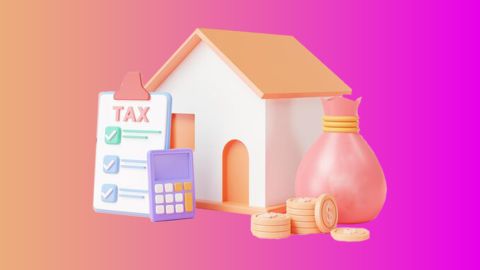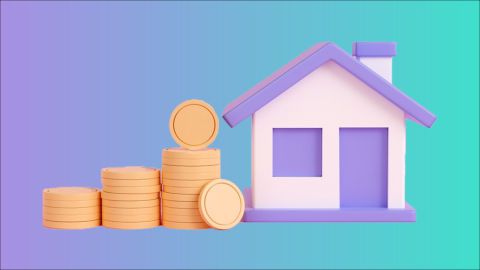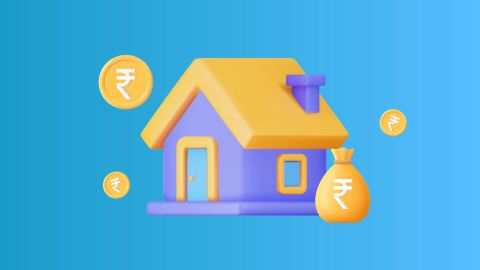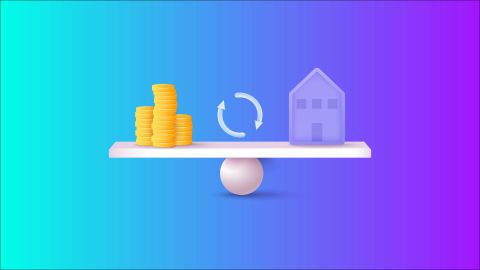Section 80EEA of the Income Tax Act offers an additional deduction of up to Rs 1.5 lakh on interest paid towards home loans for affordable housing. Introduced in Budget 2019 to boost the government’s “Housing for All” mission, this benefit is available for loans sanctioned between 1 April 2019 and 31 March 2022. It is especially helpful for first-time homebuyers and comes over and above deductions under Section 80C and Section 24. Read on to know the key features, eligibility criteria, and how to claim the deduction under Section 80EEA.
Planning to purchase your first home and looking to benefit from tax deductions? Bajaj Housing Finance offers home loans with competitive interest rates starting at 8.25% p.a. Check your eligibility for a Bajaj Housing Finance Home Loan today. You may already be eligible, find out by entering your mobile number and OTP.
Section 80EEA: Understand interest deductions on home loan
Section 80EEA of the Income Tax Act, is specifically tailored to offer deductions related to home loans. This section plays a crucial role in promoting home ownership and easing the financial burden associated with housing loans. In this article, we will delve into the features of Section 80EEA, explore the tax benefits it provides, and understand how the deduction is calculated.
Eligibility criteria to claim Section 80EEA deductions
Available only to “individual taxpayers”, Section 80EEA deduction benefits cannot be claimed by entities such as Hindu Undivided Families (HUFs), Associations of Persons (AOPs), partnership firms, companies, or any other taxpayers. Moreover, only those taxpayers opting for the old tax regime when filing their ITR can avail of Section 80EEA deduction benefits.
Conditions for claiming the deduction under Section 80EEA
To avail of the benefits under Section 80EEA, a housing loan must be obtained from a financial institution or housing finance company for the acquisition of a residential property. The loan sanction period should fall between April 1, 2019, and March 31, 2022, with the stamp duty value of the property not exceeding Rs 45 lakh. Additionally, the individual taxpayer should not be eligible for a deduction under the existing Section 80EE, and they must be a first-time homebuyer, owning no residential property as of the loan sanction date.
Conditions related to the carpet area have been outlined in the memorandum to the finance bill, although not explicitly stated in Section 80EEA. In metropolitan cities like Bengaluru, Chennai, Delhi National Capital Region (limited to New Delhi, Noida, Greater Noida, Ghaziabad, Gurgaon, Faridabad), Hyderabad, Kolkata, and Mumbai (entire Mumbai Metropolitan Region), the carpet area should not exceed 60 square meters (645 sq ft). For other cities or towns, the limit is set at 90 square meters (968 sq ft). These definitions apply to affordable real estate projects approved on or after September 1, 2019.
Section 80EEA extends the benefits introduced by Section 80EE, specifically for low-cost housing. Originally, Section 80EE allowed deductions for interest on housing loans for select financial years. Importantly, Section 80EEA does not specify residency requirements, implying that both Resident and Non-Resident Indians can claim this deduction. Additionally, it does not mandate self-occupation of the residential property, allowing individuals living in rented houses to claim the deduction. Furthermore, the deduction can be claimed jointly or singly for house purchases, with joint owners meeting the specified conditions.
How is the Section 80EEA deduction calculated?
The deduction under Section 80EEA is based on the interest paid on a home loan, subject to certain conditions. Here's how it works:
- Maximum deduction: Up to Rs. 1.5 lakh per financial year.
- Interest paid: Deduction is limited to the actual interest paid during the year.
- Loan amount limit: Applicable only if the house value is up to Rs. 45 lakh.
- Comparison for deduction: Lower of Rs. 1.5 lakh or total interest paid.
This benefit is over and above the Rs. 2 lakh deduction under Section 24(b), offering added savings for first-time homebuyers.
Maximise your tax benefits while fulfilling your dream of homeownership with Bajaj Housing Finance Home Loan. With loan amounts up to Rs. 15 crore and tenure up to 32 years, finding the right financing option is easy. Check your eligibility for a Bajaj Housing Finance Home Loan today. You may already be eligible, find out by entering your mobile number and OTP.
Features of Section 80EEA
Section 80EEA introduces provisions for individuals availing home loans, focusing on making housing more affordable. Some key features of this section include:
- Targeted at affordable housing: The deduction under Section 80EEA is primarily aimed at promoting affordable housing, making it accessible to a larger segment of the population.
- Additional deductions: Section 80EEA provides an additional deduction to the existing deductions available under Sections 24 and 80C of the Income Tax Act.
- Eligibility criteria: To avail of the benefits under Section 80EEA, the home loan must be taken from a financial institution and sanctioned between specific financial years.
Tax benefits on home loan (FY 2024-25)
Income Tax Act |
Deduction amount |
Section 24 |
Allows a deduction of Rs. 2 lakh per annum for interest paid on housing loan repayment. |
Section 80C |
Allows a deduction of Rs. 1.5 lakh per annum for the principal amount of housing loan repayment. |
Section 80EEA |
Allows a deduction of Rs. 1,50,000 per annum for interest paid on housing loan repayment. |
Looking to make the most of these tax benefits? Bajaj Housing Finance offers home loans with approval in just 48 hours and low EMIs starting at Rs. 741/lakh. Check your eligibility for a Bajaj Housing Finance Home Loan today. You may already be eligible, find out by entering your mobile number and OTP.
How is the deduction calculated under Section 80EEA
The deduction under Section 80EEA is calculated based on the interest paid on the home loan. The maximum deduction allowed is up to Rs. 1.5 lakh per financial year, subject to certain conditions. This deduction is in addition to the deductions available under Section 24B for home loan interest payments.
Tax deductions for stamp duty and registration charges
Apart from the interest component, Section 80EEA also allows deductions for expenses related to the stamp duty and registration charges incurred during the acquisition of the property. This provides further financial relief to home buyers.
Tax deductions on interest paid for properties under construction
The Income Tax Act permits the deduction of interest during both pre-construction and post-construction periods. In the case of pre-construction loans, the deductible interest is spread over five equal annual instalments, starting from the year when the residential property is acquired or completed. As a result, the total interest deduction available to a taxpayer under Section 24(b) consists of 1/5th of the interest related to the pre-construction period (if applicable) in addition to the interest associated with the post-construction period (if applicable).
Tax deduction on home loans under Section 24B
With Section 80EEA, taxpayers can also claim deductions under Section 24B for the interest paid on home loans. Section 24B addresses the general provisions related to the deduction on home loan interest.
Tax benefits on joint home loan
For individuals opting for a joint home loan, Section 80EEA offers deductions on the Home loan interest rate paid, providing an added advantage for those sharing the financial responsibility of home ownership.
Tax benefits on second home loan
Opting for a second home loan to acquire another property provides similar tax benefits, but the overall deduction amount is contingent upon the specified restrictions outlined earlier. The 2019 Union Budget introduced additional incentives to encourage real estate investments. Previously, only one property could be designated as self-occupied, and a second home was treated as let out, with notional rent calculated and taxed as income. However, there is now the provision to consider a second home as a self-occupied property.
In conclusion, Section 80EEA serves as a vital component of the Income Tax Act, fostering home ownership and providing financial relief to taxpayers. Understanding its features and intricacies enables individuals to optimise their tax planning while realising the dream of owning a home.
Ready to start your homeownership journey and enjoy these tax benefits? Bajaj Housing Finance offers flexible home loan options with zero foreclosure fees for individuals on floating interest rates. Check your eligibility for a Bajaj Housing Finance Home Loan today. You may already be eligible, find out by entering your mobile number and OTP.
Difference between Section 80EE and Section 80EEA
The comparison table below highlights the distinctions between Section 80EE and Section 80EEA:
Sno |
Section 80EE |
Section 80EEA |
1 |
Section 80EE provides tax deduction for interest on home loan up to Rs. 50,000 specifically for first-time homebuyers. |
Section 80EEA offers tax deduction on interest payments for affordable housing loans taken up to specific financial limits, providing relief to a broader spectrum of homebuyers. |
2 |
The deduction under Section 80EE is applicable only if the loan amount does not exceed Rs. 35 lakh and the property value does not surpass Rs. 50 lakh. |
Section 80EEA extends the eligibility criteria to include loans sanctioned by financial institutions and housing finance companies, facilitating access to tax benefits for a wider range of borrowers. |
3 |
Section 80EE focuses on incentivising home ownership among first-time buyers by offering additional tax benefits on housing loans. |
Section 80EEA aims to promote affordable housing initiatives by encouraging investments in this sector through tax incentives for both lenders and borrowers. |
4 |
Taxpayers can claim deductions under Section 80EE in conjunction with existing deductions under Section 24 and Section 80C of the Income Tax Act. |
Section 80EEA complements existing tax-saving provisions, enhancing the overall benefit for individuals investing in affordable housing. |
Check also:




